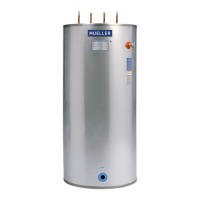Mueller Model D Fre-Heater Installation and Operation Manual Eective March 1, 1993
Part No. 8800430 Revised November 6, 2019
2.5 REFRIGERATION CONNECTIONS
Mueller Fre-Heaters are shipped with a dry nitrogen holding charge that must be removed from the Fre-Heater
piping before the installation of refrigerant piping.
Good refrigeration practices must be used while installing the Fre-Heater. These practices are of common
knowledge to experienced refrigeration service technicians, and only a certified, experienced refrigeration service
technician should undertake the refrigeration connection portion of a Fre-Heater installation.
Inlet and outlet stubs are copper tube for Freon applications and stainless steel male pipe thread for ammonia
applications. Refrigeration connection sizes for various models of Fre-Heaters are shown in Table 1.
Refrigerant line sizing to and from the Fre-Heater is determined by refrigerant specifications. Please see the
condensing unit installation manual for recommendations. If there is any question about refrigerant line sizing,
follow the equipment manufacturer’s recommendation.
In most instances, refrigerant line runs of over 50 feet should not be used. If a refrigerant line run of over 50 feet is
used, particular care must be taken to avoid oil traps and excessive pressure drop in the lines.
CAUTION: Refrigerant lines going to and from Mueller Fre-Heaters could reach temperatures of 300°F.
Refrigerant lines must be insulated to prevent personal injury or other risks when near combustible
substances. The insulation will also add to the efficient operation of the Fre-Heater.
If it is necessary to cut openings into the air conditioning or refrigeration cabinet when making tubing connections,
the following must be observed and provided for. Particular care must be taken if the equipment is located outdoors:
• Integrity and rain tightness of the cabinet must be maintained.
• Do not cut into a control box or enclosure containing live mechanical parts or electrical wiring. Make openings
below any enclosures containing live mechanical parts or electrical wiring.
• Tubing must be protected against mechanical damage by the cabinet. Protective bushings are recommended.
• Tubing connections must be made by means of high-temperature soldering or brazing.
• Tubing must be routed such that no possibility of contacting moving parts occurs.
• Provide protection for the tubing if the likelihood of accidental damage occurring exists.
• Always use a gear-type tubing bender when making bends in
3
⁄4" or
7
⁄8" OD tubes. A conduit bender will flatten
the tubing and restrict the flow of refrigerant.
• When installing tubing through walls or along a structural member, ensure the tubing is isolated from the
members to avoid any transmissions or vibrations that might occur.
10

